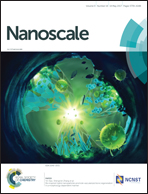Radio frequency negative permittivity in random carbon nanotubes/alumina nanocomposites†
Abstract
While metal is the most common conductive constituent element in the preparation of metamaterials, one-dimensional conductive carbon nanotubes (CNTs) provide alternative building blocks. Here alumina (Al2O3) nanocomposites with multi-walled carbon nanotubes (MWCNTs) uniformly dispersed in the alumina matrix were prepared by hot-pressing sintering. As the MWCNT content increased, the formed conductive MWCNT networks led to the occurrence of the percolation phenomenon and a change of the conductive mechanism. Two different types of negative permittivity (i.e., resonance-induced and plasma-like) were observed in the composites. The resonance-induced negative permittivity behavior in the composite with a low nanotube content was ascribed to the induced electric dipole generated from the isolated MWCNTs. The frequency dispersions of such negative permittivity can be fitted well by the Lorentz model, while the observed plasma-like negative permittivity behavior in the composites with MWCNT content exceeding the percolation threshold could be well explained by the low frequency plasmonic state generated from conductive nanotube networks using the Drude model. This work is favorable to revealing the generation mechanism of negative permittivity behavior and will greatly facilitate the practical applications of metamaterials.



 Please wait while we load your content...
Please wait while we load your content...